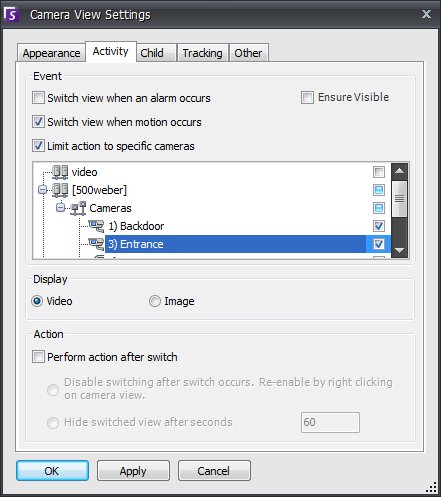
Each video panel can be configured with advanced options. A video panel can be in the Multi View or Main Console. Right clicking on the camera view launches a dialog box with several settings for appearance, what to do when activity occurs, digital tracking, and other miscellaneous options.
Appearance Tab
Timeline: enables or disables whether Timeline height should be resized automatically.
Video Decorations Overlay: Select if video decorations should be enabled or disabled.
Stream Selector: If camera selects multiple video streams, select which video stream to display.
Activity Tab
Force a Video Panel to automatically switch when an event occurs. This is useful if you want to have a 4 Multi View open and are monitoring 1000 cameras where there is rarely activity. The 4 Video Panels within a Multi View window can be configured to always show video from the last 4 cameras that had activity by using this page.

Event
The switching event can be an alarm (defined in Rules), or it can be motion (detected by motion analytics engines such as VE150, VE160, VE250). Note that an alarm can be from an I/O device that is associated with a camera.
Limit action to specific cameras
If you are connected to many farms/servers/cameras you may want a view to only automatically switch to a subset of all the cameras. Check off the cameras that should be in this set.
Display
Choose whether you want to automatically switch to the live video or if you want to automatically switch to the still image.
Action - Disable switching after switch occurs
Imagine a Video Panel switches, then the operator watches the camera, then another alarm occurs on a different camera that would cause a second switch to this view. The operator may be frustrated that the view automatically changed. With this option the operator needs to right click on the live view and select the Enable Automatic Switching menu option to re-enable the switching.
Action - Hide switched view after seconds
If the view should be blank unless an event of interest has occurred, then pick this option. When no event has occurred, the panel will be black with the text ”r;Waiting for event”. When an event occurs, the video will popup and a countdown timer will be displayed that shows how many seconds are left until we enter the ”r;Waiting for event” state. The number of seconds to wait before blacking out the live view can be specified in the text box.
Further explanation:
Symphony will not automatically switch a Video Panel to a camera that is already being displayed in another camera panel in that Multi-View.
After a Video Panel automatically switches it will not automatically switch to another camera for 8 seconds.
If multiple Video Panels within a Multi View would switch based on activity, only one will switch - the one that switched furthest in the past. Each Multi View operates independently, therefore if you have 2 cameras in different Multi Views set to automatically switch based on activity, they may both be showing the same camera.
If you want to ”Hide view until next event” a single time, don’t set it through this setting panel, rather right click on the Video Panel and select the ”Hide view until next event” option. Doing it this way will not automatically hide the view again after the next event.
If you want to have a listing of the most recent alarm/motion images, use the View / Recent Alarm/Motion JPEGs window.
Child Tab
The Slave tab allows you to force a Video Panel (Slave Video Panel) to always show the latest alarm image for the camera being displayed in another Video Panel (Primary Video Panel). When you change the camera being shown in Primary Video Panel (either automatically or manually) the Slave Video Panel switches to the most recent alarm. The ID of the view to enter in the text box is in the red rectangle for the Video Panel Settings of the Primary Video Panel.
Tracking Tab
Enable or disable digital tracking whereby the client software will automatically digitally zoom on activity.
Other
Applies changes to all video panels.